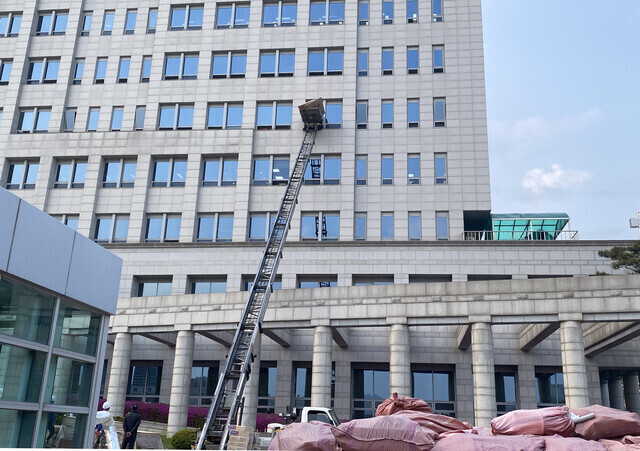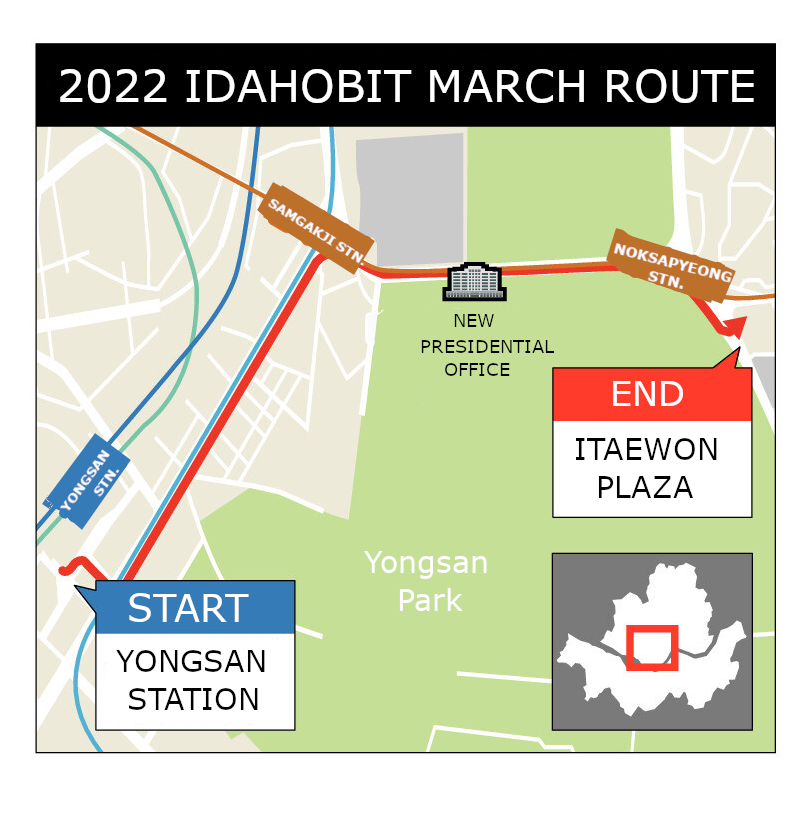hankyoreh
Links to other country sites 다른 나라 사이트 링크
Will anti-discrimination march be able to pass in front of new S. Korean presidential office?

With the South Korean president’s office and official residence set to be split between the Ministry of National Defense complex in Yongsan and the residence of the minister of foreign affairs, a debate is growing over whether it will be possible to hold demonstrations within 100 meters of the presidential office.
Currently, South Korean law has no regulations on demonstrations when it comes to the presidential office, but stipulates a ban on demonstrations within 100 meters of the president’s official residence.
A court case is now underway to determine whether it will be possible to hold assemblies and demonstrations in the vicinity of the office of President-elect Yoon Suk-yeol — a figure who pledged to “approach communication with the public along White House lines” during his term.
Rainbow Action, a group opposing discrimination against LGBTQ people, filed suit on Monday after the police barred its members from marching in front of the presidential office.
The group had planned to march a roughly 3-kilometer route from the plaza at Yongsan Station to Itaewon on May 14 to commemorate the International Day Against Homophobia, Biphobia, Intersexphobia and Transphobia (IDAHOBIT) on May 17. Police prohibited its members from marching along a portion of the route on the grounds that it fell within 100 meters of the presidential office.
As a basis for their decision, police cited a provision in the Assembly and Demonstration Act prohibiting outdoor assemblies “within a 100-meter radius from the boundary of [. . .] the Presidential residence.”
Rainbow Action filed suit with the Seoul Administrative Court for an injunction to have the police’s ban suspended and overturned. This was the first lawsuit to be filed in connection with demonstrations near the new presidential office in Yongsan.
Attorney Seo Chae-wan, who is representing Rainbow Action, said Wednesday that the “key question is whether ‘presidential residence’ and ‘presidential office’ can be viewed as the same concept.”
“It’s a question that has newly emerged with the relocation of the presidential office from the Blue House [where the office and residence were combined in one location],” he explained.
“If you look at previous precedents, they’ve viewed the ‘residence’ and ‘office’ as different concepts,” he added.
No consistent conclusion has emerged from courts on whether the presidential office is included in the scope of the “presidential residence.” With both the residence and office previously located within the confines of the Blue House, few lawsuits have required any distinction between the two.

One court decision in 2016 concluded that the residence and office should be viewed as different.
At the time, the group People’s Solidarity for Participatory Democracy filed suit after it reported a planned demonstration in front of the Blue House’s Yeonpung Gate entrance, only to have police ban it on the grounds that it fell within a 100-meter radius of the presidential residence.
While the judge ultimately sided with the police, they also noted in their ruling that the presidential residence “is distinguished from the presidential office and other working facilities, with its own separate surrounding barrier.”
Other rulings have more broadly interpreted the presidential residence as meaning “the place where a president principally performs their duties and resides.”
In 2006, a lawsuit was filed in response to a ban on a reported demonstration on the sidewalk in front of the Cheongun neighborhood office near the Blue House. At the time, the court interpreted “presidential residence” as encompassing “the literal location where the president chiefly performs duties and resides, along with essential accessory buildings used by people assisting or guarding the president and the associated sites.”
Analysts in the legal world offered different interpretations.
Yang Hong-seok, an attorney with the firm Yi-Gong Lawyers, said, “The Assembly and Demonstration Act explicitly says the ‘Presidential residence,’ but it’s difficult to understand interpreting that as also including the presidential office and restricting the public’s basic rights on that basis.”
Kim Han-gyu, an attorney with the law firm Gonggan, said, “If you view it generally in terms of the president’s safety and issues of security and order, it seems difficult to view [the residence and office] as separate.”
Others said that with Yoon offering “communication with the public” as a justification for his decision to relocate his office, he should take the opportunity to move in a direction of greater permission of assemblies and demonstrations in front of that office.
In the case of the White House, which established itself as a top global destination for assemblies and demonstrations in the wake of picketing for women’s suffrage in January 1917, demonstrators are required to submit requests for approval to the head of the presiding police station with the time and place of demonstration indicated. But in accordance with the First Amendment, demonstrations are only actually restricted in cases that are deemed to pose threats to public order.
Due to the lack of similar regulations banning demonstrations within a 100-meter radius, the White House has been the setting for hundreds of assemblies and demonstrations each year in connection with government policies such as firearm regulations.
On Monday, organizations behind the 2022 IDAHOBIT joint action, including the group MINBYUN-Lawyers for a Democratic Society, released a statement that read, “Given that it is the constitutional interpretation of the law to permit peaceful marches that do not pose any direct dangers, the Yongsan Police Station’s prohibition announcement is a violation of the constitutional freedom of assembly and demonstration.”
“As a president-elect who has emphasized ‘communication’ in the relocation of the presidential office, [Yoon] should take a serious view of and issue a clear statement on the current situation of the freedom of assembly being arbitrarily violated by police,” the groups added.
By Shin Min-jung, staff reporter
Please direct questions or comments to [english@hani.co.kr]

Editorial・opinion
![[Column] The state is back — but is it in business? [Column] The state is back — but is it in business?](https://flexible.img.hani.co.kr/flexible/normal/500/300/imgdb/original/2024/0506/8217149564092725.jpg) [Column] The state is back — but is it in business?
[Column] The state is back — but is it in business?![[Column] Life on our Trisolaris [Column] Life on our Trisolaris](https://flexible.img.hani.co.kr/flexible/normal/500/300/imgdb/original/2024/0505/4817148682278544.jpg) [Column] Life on our Trisolaris
[Column] Life on our Trisolaris- [Editorial] Penalties for airing allegations against Korea’s first lady endanger free press
- [Editorial] Yoon must halt procurement of SM-3 interceptor missiles
- [Guest essay] Maybe Korea’s rapid population decline is an opportunity, not a crisis
- [Column] Can Yoon steer diplomacy with Russia, China back on track?
- [Column] Season 2 of special prosecutor probe may be coming to Korea soon
- [Column] Park Geun-hye déjà vu in Yoon Suk-yeol
- [Editorial] New weight of N. Korea’s nuclear threats makes dialogue all the more urgent
- [Guest essay] The real reason Korea’s new right wants to dub Rhee a founding father
Most viewed articles
- 1Amid US-China clash, Korea must remember its failures in the 19th century, advises scholar
- 2[Column] Why Korea’s hard right is fated to lose
- 3[Column] The state is back — but is it in business?
- 4Trump’s talk of flouting NATO promises sparks apprehension in Seoul
- 560% of young Koreans see no need to have kids after marriage
- 6New sex-ed guidelines forbid teaching about homosexuality
- 7Presidential office warns of veto in response to opposition passing special counsel probe act
- 8[Column] Can Yoon steer diplomacy with Russia, China back on track?
- 9[Guest essay] Maybe Korea’s rapid population decline is an opportunity, not a crisis
- 10[Reporter’s notebook] In Min’s world, she’s the artist — and NewJeans is her art